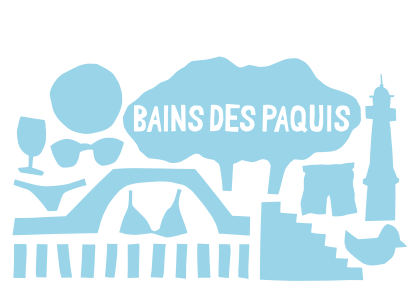The association

The Creation
Les Bains des Pâquis has been in existence since 1872. First built of wood, then extended in 1889 on stilts, they were rebuilt in 1931-1932. In 1890, the baths became public and municipal. They were chargeable from 7 a.m. to 6 p.m. on weekdays, and free on Sundays and public holidays. A few free hours were reserved for women to avoid promiscuity.
The city of Geneva decided to rebuild the baths in 1932. The simple wooden huts were demolished to make way for a complete reinforced concrete jetty. The project chosen was that of engineer Louis Archinard and architect Henry Roche, which offered perfect equality between men and women, and a surface area of 6,500 m2. The first of the 448 piles was planted on January 20, 1932.
It was a total success, with Genevans making the site their own and their favorite summer spot. Combining calm, sports, health and leisure, the Baths are also imbued with a social and socializing aspect that has not escaped the notice of its users. At the end of the 1980s, a project was launched to rebuild the baths. But reconstruction means demolition. Why such a project when renovation would preserve the spirit of the Baths…?
The destruction project
In the early ’80s, rumors spread through the streets of Pâquis… from one bath towel to another, around the bar tables and under the plane trees. The City of Geneva wants to transform the Bains des Pâquis! Users feel betrayed by a project that in no way respects the spirit of the Bains. It may be prestigious, but it doesn’t meet bather expectations. How to convince the city that the Baths should be renovated without being modified.
What makes the Bains so special is their conviviality, their mix of generations and genres, their sobriety and their popularity. A whole host of elements ensure that you’ll meet up with friends from one summer to the next, that you’ll get used to the place, and that you’ll feel like you’re on vacation as soon as you sit down at the refreshment bar. The City of Geneva has underestimated the emotional attachment of Genevans to the Pâquis baths.
It’s time to mobilize! Users and local residents launch a protest campaign. In February 1987, defenders of the Bains formed an association to lodge an appeal against the project: the Association d’usagers des Bains des Pâquis (AUBP) was born.
Meetings with architects and elected representatives follow. The AUBP is campaigning to make it clear that the demolition-reconstruction project does not correspond to the expectations of users, who simply want the Bains to be renovated. It was a failure, and the City Council voted to shelve the project in December 1987. The AUBP then decided to launch a referendum so that the people of Geneva could decide on the future of the Bains: over 9,000 signatures were quickly collected and the referendum was filed.


The fight
The referendum was scheduled for September 25, 1988. AUBP needs to convince the public that renovating the Bains is technically feasible, and that it will cost less than demolishing and rebuilding.
Faced with the City of Geneva’s disastrous diagnosis that the baths should be demolished because of concrete disease, AUBP carried out its own assessment of the 513 pillars and found that only a dozen were affected by carbonation. A counter-expertise revealed that the Bains were repairable, and a new project by architects sympathetic to the Bains was proposed.
The campaign is financed by the shows and parties organized at the Bains des Pâquis: artists and musicians perform free of charge. Graphic designers, film-makers and cartoonists also get involved to give the voting posters a particularly colorful signature. Journalists, shopkeepers, community centers, cultural centers – the whole town rallied round, and on September 25 1988, nearly 17,000 citizens, 72% of them voters, voted NO to the disappearance of the Bains.

The architecture
A simple, harmonious construction, the Bains des Pâquis blend discreetly into the landscape of the harbor. Backing onto the jetty, the pools give bathers a view of the city, while the beaches open onto the entire lake. Its simplicity and architectural clarity make it a timeless building dear to the hearts of Genevans. This space, described by some as ethno-territory, illustrates the relationship between the individual and his or her urban environment. Each area of the Spa is imbued with the emotional dimension and memory of the Spa. Everything has been done to enable bathers to make the area their own, and to make the most of it, combining tranquility and conviviality.
“Upstream from the jetty, the lakeside configuration dominates the environment, while downstream, the bathing platform provides a generous view of the city. Between these two orientations, elementary spaces put us in touch with the administration (reception), the sky (cabin corridors), bodies of water, conviviality (the refreshment bar), and a scenic escape to Lake Geneva (the beach). Alternating between open and enclosed spaces, between visual perspectives and screens of different kinds, between spaces in the water and spaces on the water. The organization of the plan avoids monumentality and illustrates the right balance.
The layout reflects a sense of practicality, rational simplicity, the relative paucity of the materials used, and an attitude of modesty in keeping with the landscape. Knowledge of the nature of the lake bed and its hydraulic characteristics enabled the construction of a stable building resting on several hundred concrete pillars. The legibility of the construction takes into account the constraints of the aquatic environment and the site.” (Marcellin Barthassat, architect).




